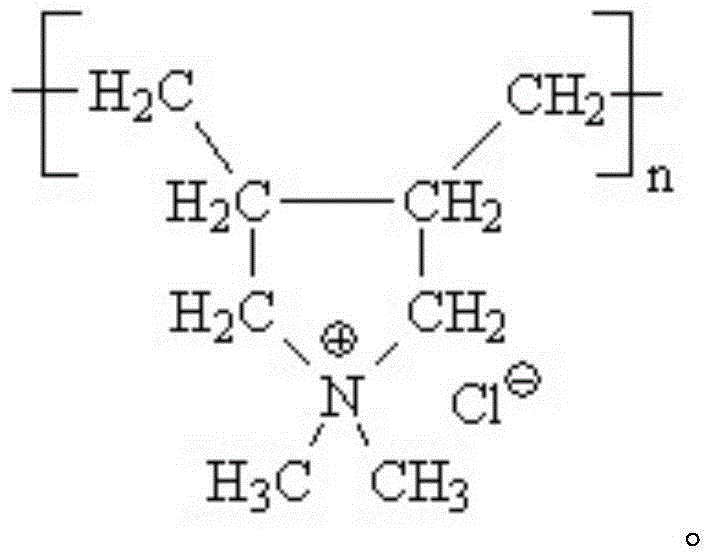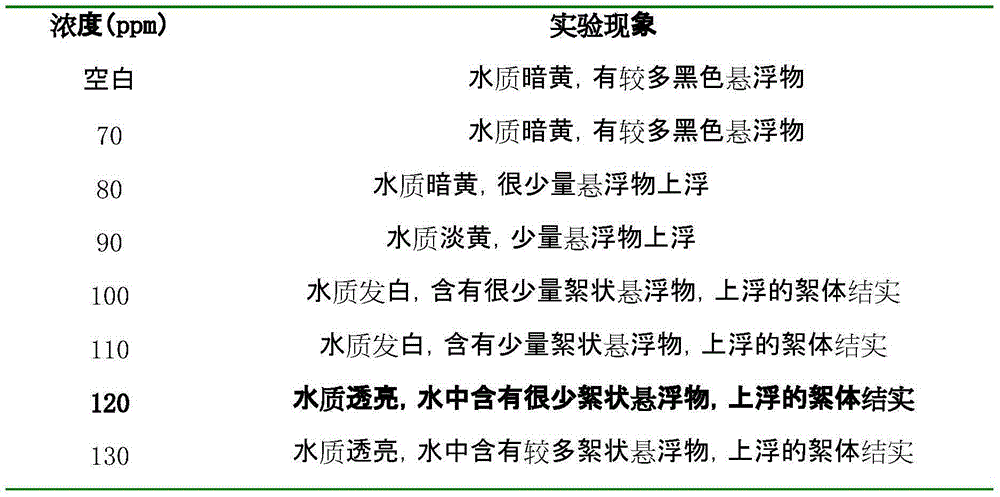Organic macromolecular flocculating agent for polymer-bearing sewage and preparation method for organic macromolecular flocculating agent
An organic polymer, sewage treatment technology, applied in the direction of flocculation/sedimentation water/sewage treatment, etc., can solve the problems of subsequent process and adverse environmental impact, large on-site environmental impact, large amount of sludge, etc., to achieve high-efficiency water purification effect and cost. Inexpensive, less flocculent effect
- Summary
- Abstract
- Description
- Claims
- Application Information
AI Technical Summary
Problems solved by technology
Method used
Image
Examples
Embodiment 1
[0019] Each raw material component is selected according to mass percentage: polyaluminum chloride is 30%, and the mass of nonionic polyacrylamide is 5% of the mass of polyaluminum chloride; The mass ratio is 1:2; use absolute ethanol and distilled water to prepare a polyaluminum chloride solution with a mass percent concentration of 40% at room temperature (the volume ratio of distilled water to absolute ethanol is 3:1), and put it into a four-hole container with a stirrer. In the bottle, heat up to 50°C, add a certain amount of non-ionic polyacrylamide; fully stir at constant temperature for 20 minutes to fully dissolve; then use a separatory funnel to slowly add polydimethyldiallylammonium chloride dropwise, and Raise the temperature to 65°C, the polymerization reaction occurs, and control the temperature, the dropwise addition is completed within 3 hours; then raise the temperature to 80°C, add an appropriate amount of dilute sulfuric acid dropwise to adjust the pH value to...
Embodiment 2
[0026] Select each raw material component according to mass percentage: polyaluminum chloride is 35%, and the mass of nonionic polyacrylamide is 5% of polyaluminum chloride mass; Polydimethyl diallyl ammonium chloride and polyaluminum chloride The mass ratio is 1:3; use absolute ethanol and distilled water to prepare a polyaluminum chloride solution with a mass percent concentration of 40% at room temperature (the volume ratio of distilled water to absolute ethanol is 3:1), and put it into a four-hole container with a stirrer. In the bottle, heat up to 50°C, add a certain amount of non-ionic polyacrylamide; fully stir at constant temperature for 20 minutes to fully dissolve; then use a separatory funnel to slowly add polydimethyldiallylammonium chloride dropwise, and Raise the temperature to 65°C, the polymerization reaction occurs, and control the temperature, the dropwise addition is completed within 3 hours; then raise the temperature to 80°C, add an appropriate amount of di...
Embodiment 3
[0034] Select each raw material component according to mass percentage: polyaluminum chloride is 35%, and the mass of nonionic polyacrylamide is 5% of polyaluminum chloride mass; Polydimethyl diallyl ammonium chloride and polyaluminum chloride The mass ratio is 2:3; use absolute ethanol and distilled water to prepare a polyaluminum chloride solution with a mass percent concentration of 40% at room temperature (the volume ratio of distilled water to absolute ethanol is 3:1), and put it into a four-hole container with a stirrer. In the bottle, heat up to 50°C, add a certain amount of non-ionic polyacrylamide; fully stir at constant temperature for 20 minutes to fully dissolve; then use a separatory funnel to slowly add polydimethyldiallylammonium chloride dropwise, and Raise the temperature to 65°C, the polymerization reaction occurs, and control the temperature, the dropwise addition is completed within 3 hours; then raise the temperature to 80°C, add an appropriate amount of di...
PUM
 Login to View More
Login to View More Abstract
Description
Claims
Application Information
 Login to View More
Login to View More - R&D
- Intellectual Property
- Life Sciences
- Materials
- Tech Scout
- Unparalleled Data Quality
- Higher Quality Content
- 60% Fewer Hallucinations
Browse by: Latest US Patents, China's latest patents, Technical Efficacy Thesaurus, Application Domain, Technology Topic, Popular Technical Reports.
© 2025 PatSnap. All rights reserved.Legal|Privacy policy|Modern Slavery Act Transparency Statement|Sitemap|About US| Contact US: help@patsnap.com



